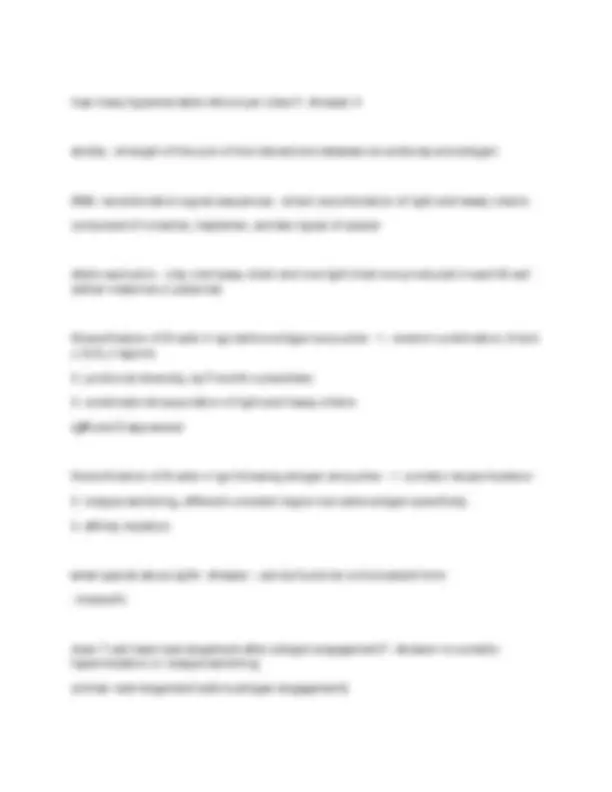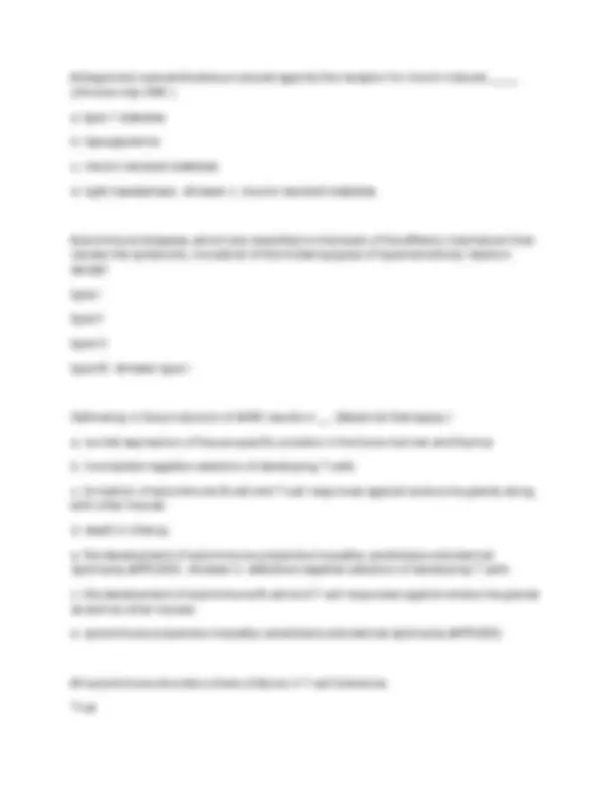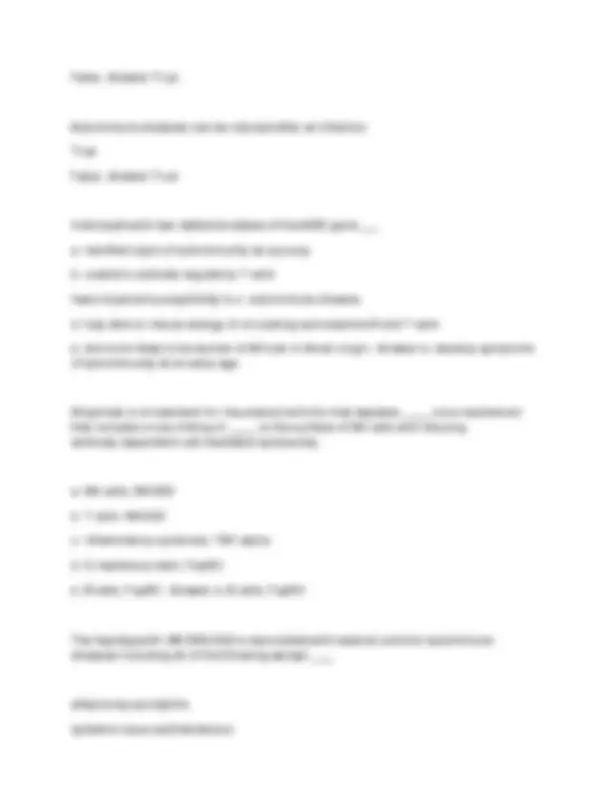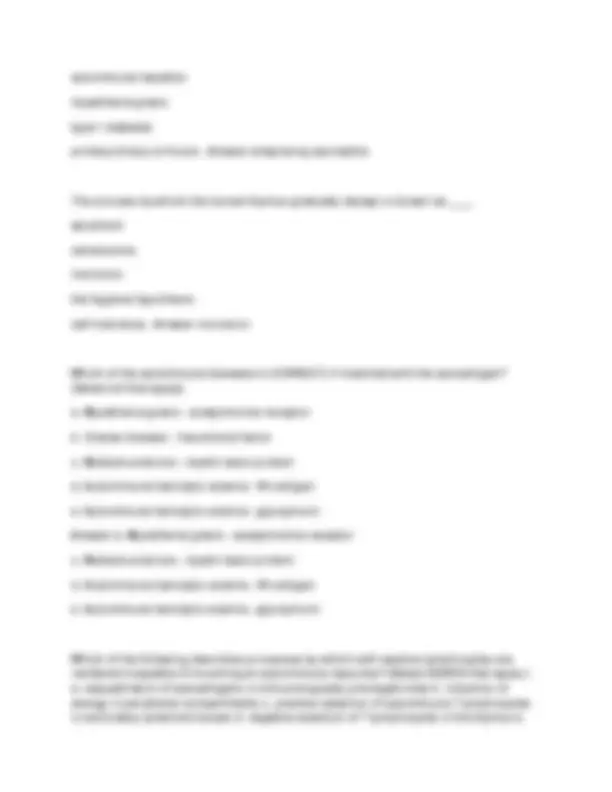








Study with the several resources on Docsity

Earn points by helping other students or get them with a premium plan


Prepare for your exams
Study with the several resources on Docsity

Earn points to download
Earn points by helping other students or get them with a premium plan
Community
Ask the community for help and clear up your study doubts
Discover the best universities in your country according to Docsity users
Free resources
Download our free guides on studying techniques, anxiety management strategies, and thesis advice from Docsity tutors
MCMP422 Final Exam Questions And Correct Answers
Typology: Exams
1 / 12

This page cannot be seen from the preview
Don't miss anything!







What product do paneth cells produce? - Reg3G upon exposure to PAMPs
where do complements synthesized? - liver
three pathways of complement activation - alternative, lectin, classical
complement control proteins - CCP Regulate all three pathways of complement activation and protect the host from their destructive effects.
what complement control protein stabilizes the C3 convertase? - properdin
what complement control protein inactivare C3b - factor H and I
what complement control protein protect healthy human cells - Answer DAF and MCP
what complement control protein inactivate MAC? - Answer CD
how do C3a and C5a contrtibute to anaphylatory response - Answer increase vascular permeability and access to bacteria to recruit immune response
Function of A2-macroglobulin - Answer microbial protease cleaves bite of a2-macroglobulin, inducing conformational change. a1-macroglobulin enshrounds and inactivates the protease
defensins - Answer antimicrobial peptides that inhibit microbial growth amphipathic
Pentraxins-plasma proteins of innate immunity that bind microorganisms and target them to phagocytes
scavenger receptor-binds to negative charged molecules
what does TLR4 recognize?-lipopolysaccharide of gram-negative bacteria
leucine rich repeat-repeating unit of TLR
NEMO-deficiency resulting in susceptibility to bacterial infections because NFkB is impaired abnormal development of teeth
what does TLR3 recognize?-dsRNA in cytoplasm (endosomal)
what does NOD-like receptor recognize? -Answer bacterial degradation products in the cytoplasm.
what does RIG-1 like receptor recognize? - Answer binds to viral RNA and induces secretion of IFN a and b
inflammasomes - Answer protein complex that increases the production of IL-1B and enable activated macrophage to release a large burst of IL-
Pyroptosis - Answer macrophage dies and releases cytokines including IL-1B
how many hypervariable refions per chain? - Answer 3
avidity - strength of the sum of the interactions between an antibody and antigen
RSS- recombination signal sequences - direct recombination of light and heavy chains composed of nonamer, heptamer, and two types of spacer
allelic exclusion - only one heavy chain and one light chain are produced in each B-cell (either maternal or paternal)
Diversification of B cells in Igs before antigen encounter - 1. random combination, V and J, V,D,J regions
Diversification of B cells in Igs following antigen encounter - 1. somatic herpermutation
what special about IgG4 - Answer - can be found an a monovalent form
does T cell have rearrangement after antigen engagement? - Answer no somatic hypermutation or isotype switching (similar rearrangement before antigen engagement)
what does selectin recognize? - Answer sugar
what is result of AID deficiency (nicks switch DNA) - Answer IgM syndrome
Select all that apply. Which of the following is a characteristic of γ:δ T cells. -Some express a homodimer of the CD8 α chain. -They do not express CD28. -They are subject to MHC restriction. -Most do not express either CD4 or CD8. -Most circulating cells do not enter secondary lymphoid tissue. -They undergo gene rearrangement. -They originate from the same precursor cells as do α:β T cells. -Their response is solely dependent on the T-cell receptor. -They make up the minority of resident T cells in tissues.
Autoimmune diseases are rarely resolved. True False -Answer True
Which of the following is characteristic of myasthenia gravis?
a. Ectopic lymphoid tissue forms and impairs endocrine function. b. Disruption of adhesion molecules of cellular junctions. c. Autoimmune response to proteins of anterior chamber of the eye. d. Chronic inflammation of the gut mucosa. e. The neuromuscular junction is compromised. - Answer e. The neuromuscular junction is compromised.
Which of the following is an example of a type II autoimmune response? (Select all that apply) a. Graves disease b. multiple sclerosis c. systemic lupus erythematosus d. myasthenia gravis Answer a. Graves disease d. myasthenia gravis
Which of the following is the cause of red blood cell deficiency in autoimmune hemolytic anemia? (Select all that apply.)
a. failure of red blood cells to develop normally in the bone marrow b. destruction of red blood cells resulting from widespread pinpoint hemorrhages c. hemolysis due to formation of membrane-attack complexes d. phagocyte mediated clearance in the spleen e. quick destruction of red blood cells as a result of killing by the CD8 T cells - Answer c. hemolysis induced by assembly of membrane-attack complexes d. phagocyte-mediated clearance in the spleen
Antagonistic autoantibodies produced against the receptor for insulin induces _____. (Choose only ONE.) a. type 1 diabetes b. hypoglycemia c. insulin-resistant diabetes d. light-headedness - Answer c. insulin-resistant diabetes
Autoimmune diseases, which are classified on the basis of the effector mechanism that causes the symptoms, include all of the following types of hypersensitivity reaction except type I type II type III type IV - Answer type I
Deficiency in the production of AIRE results in __. (Select all that apply.) a. normal expression of tissue-specific proteins in the bone marrow and thymus b. incomplete negative selection of developing T cells c. formation of autoimmune B-cell and T-cell responses against endocrine glands along with other tissues d. death in infancy e. the development of autoimmune polyendocrinopathy-candidiasis-ectodermal dystrophy (APECED) - Answer b. defective negative selection of developing T cells c. the development of autoimmune B-cell and T-cell responses against endocrine glands as well as other tissues e. autoimmune polyendocrinopathy-candidiasis-ectodermal dystrophy (APECED)
All autoimmune disorders share a failure in T-cell tolerance. True
autoimmune hepatitis myasthenia gravis type 1 diabetes primary biliary cirrhosis - Answer ankylosing spondylitis
The process by which the human thymus gradually decays is known as ____. apoptosis senescence involution the hygiene hypothesis self-tolerance - Answer involution
Which of the autoimmune diseases is CORRECTLY matched with the autoantigen? (Select all that apply). a. Mysathenia gravis - acetylcholine receptor b. Graves disease - rheumotoid factor c. Multiple sclerosis - myelin basic protein d. Autoimmune hemolytic anemia - Rh antigen e. Autoimmune hemolytic anemia - glycophorin Answer a. Mysathenia gravis - acetylcholine receptor c. Multiple sclerosis - myelin basic protein d. Autoimmune hemolytic anemia - Rh antigen e. Autoimmune hemolytic anemia - glycophorin
Which of the following describes processes by which self-reactive lymphocytes are rendered incapable of mounting an autoimmune response? [Select SEVEN that apply.] a. sequestration of autoantigens in immunologically privileged sites b. induction of anergy in peripheral compartments c. positive selection of autoimmune T lymphocytes in secondary lymphoid tissues d. negative selection of T lymphocytes in the thymus e.
suppression by regulatory T cells f. negative selection of B lymphocytes in the bone marrow g. expression of AIRE in the bone marrow h. induction of alloreactive responses it the thymus i. somatic hypermutation to an alternative antigen specificity j. apoptosis in primary lymphoid tissue k. deprivation of T-cell help - Answer abdefjk
_____ autoantibodies enhance receptor function. neutralizing opsonizing agonist complement-fixing antagonist - Answer agonist
____ is an example in which physical trauma provides access of lymphocytes to an otherwise immunologically privileged site. (Select only ONE). Joint trauma Liver trauma Pancreatic trauma Thyroid trauma Eye trauma - Questions Eye trauma
___ is the phenomenon that pathogen antigens often cross-react with host antigens and sometimes give rise to autoimmune disease. intramolecular epitope spreading molecular mimicry intermolecular epitope spreading